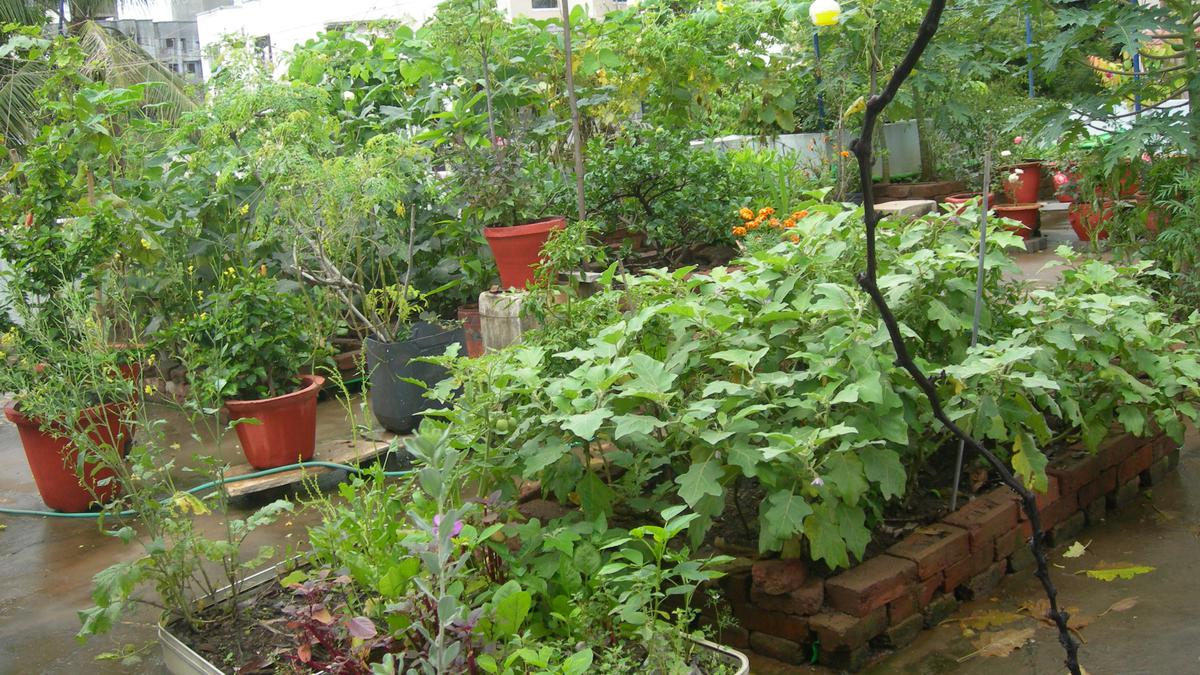
A case for urban farming in Bengaluru Premium
The Hindu
Brijinder Kathuria remembers being conflicted about choosing between growing more organic food or planting more forests for a long time. “A lot of deforestation happens because people chop off forest land to farm,” says the Bengaluru-based Brijinder, a passionate eco-enthusiast who works in the technology sector. Then, he stumbled upon permaculture farming, a way of creating synergetic, sustainable agriculture systems that closely resemble natural ecosystems—in short, you’re making food forests. “That hit the sweet spot,” says the former hotelier, who went on to cultivate a food forest with perennial plants like bananas, coffee, coconut and jackfruit on his 5000 sq ft plot, enough to sustain himself for anywhere between 1.5 to 2 months, he says. “Freshly plucked food tastes a new level,” says the former hotelier, who admits to always being drawn to fresh food and ingredients.
Brijinder Kathuria remembers being conflicted between growing more organic food or planting more forests for a long time. “A lot of deforestation happens because people chop off forest land to farm,” says the Bengaluru-based Brijinder, a passionate eco-enthusiast who works in the technology sector. Then, he stumbled upon permaculture farming, a way of creating synergetic, sustainable agriculture systems that closely resemble natural ecosystems—in short, you’re making food forests. “That hit the sweet spot,” says the former hotelier, who went on to cultivate a food forest with perennial plants like bananas, coffee, coconut and jackfruit on his 5000 sq ft plot, enough to sustain himself for anywhere between 1.5 to 2 months, he says. “Freshly plucked food takes taste to a new level,” says the former hotelier, who admits to always being drawn to fresh food and ingredients.
Like Brijinder, many Bengalureans are discovering the allure of urban agriculture, taking pleasure in getting their hands dirty, for many or all these reasons: better access to more nutritious food, creating communities, reducing environmental impact, managing mental health and connecting to nature. As a recent publication by the Indian Institute for Human Settlements (IIHS), the result of a three-year-long research project titled Sowing Sustainable Cities points out, “urban and peri-urban agriculture is gaining in popularity and impact, and can become a critical strategy for transitioning towards sustainable urban futures.”
So, where does Bengaluru stand as a city when it comes to creating urban foodscapes? What are the inherent advantages offered by this former garden city when it comes to cultivating green spaces? What challenges do city slickers face when it comes to growing their own food? And how does succeeding in doing so change their relationship with the food on your plate and the earth from where it springs? This is what the city’s urban farmers have to say.
Farming and the city
“It is difficult to kill a plant in Bengaluru,” says Sheetal Patil, a senior research consultant at IIHS who was part of the research project. The soils, she points out, are fertile, while the weather is favourable throughout the year for growing.“The weather is not extreme,” agrees agri-scientist and entomologist Dr. Rajendra Hegde of Garden City Farmers, a city-based trust founded by the late B.N. Viswanath, which promotes urban farming. The humidity and number of rainy days in the city are also favourable for gardening, says Dr. Rajendra, adding that today, lakhs of people have food gardens in the city.
“We can grow things all through the year here,” says Bengaluru-based artist Suresh Kumar G., the founder of Sarjapura Curries, a city-based community farm that seeks to revive forgotten native plants and weeds. Moreover, as he points out, the city has always had an active garden culture right from the days of Hyder Ali. “The British experimented in Lal Bagh, too,” says Suresh. “It made sense to grow vegetables here.”
Not surprisingly, there is a large, well-connected gardening community in the city who “chat, exchange ideas and take pride in how good their garden is,” says Sheetal. “Seeing and following some of the practices is inspiring.” Dr. Rajendra, whose organisation has played a pivotal role in increasing awareness about the practice through workshops and lectures, says that there are today over 25 terrace gardening groups in the city, each having a minimum of 50-60 members. “They meet every month, share information, purchase materials for gardening together, and so on,” he says.











